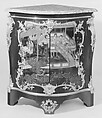Corner cabinet (encoignure) (one of a pair)
In January 1750 and April 1751, the Parisian marchand-mercier Lazare Duvaux (ca. 1703–1758) sold two pairs of corner cabinets for 580 and 650 livres, respectively. Veneered with Coromandel lacquer and mounted with gilt bronze, they were fitted with Antin marble tops. Although the descriptions are too brief to permit a positive identification with the Museum’s pair, whose tops, moreover, are of a different type of marble (perhaps replacements), these entries in the famous dealer’s account book offer a good idea of the considerable cost of such corner cabinets. Furthermore, based on his sale records for the period 1748–53, it appears there was a demand for case furniture embellished with Coromandel lacquer. Duvaux sold several such pieces to his frequent customer Madame de Pompadour, the king’s mistress. Distinguished by designs that are not painted on the surface but incised and filled with colored lacquer, objects decorated in this Chinese technique were shipped to Europe by way of the Coromandel coast of southeast India, hence the name.
The Parisian furniture maker Bernard II van Risenburgh, who stamped both pieces, made a number of corner cabinets fitted with either a single door or a double set of doors, depending on the size of the Asian lacquer panels made available to him by the marchand-mercier. In this case, he used tall and narrow pieces cut from a large multileaf Coromandel screen—which explains why the scenes on the doors are not continuous. As if it were a single panel, the lacquer is framed by sinuous Rococo-style gilt-bronze mounts incorporating C-scrolls and floral trails. The mounts appear to have been cast as one piece but, in fact, they consist of a number of different elements that overlap, some of which are stamped with the crowned-C tax mark. Based on these marks (the C stands for cuivre, or copper, the main ingredient of bronze), the mounts can be dated between February 1745 and February 1749, when this tax, imposed by a royal edict, was in effect. Any piece of decorative bronze above a certain weight sold during that period had to be struck with the crowned-C stamp to show that duty had been paid. Mounts like this are found on other pieces by Van Risenburgh, as well; the cartouche-shaped mount on the central leg is a later addition.
Due to rights restrictions, this image cannot be enlarged, viewed at full screen, or downloaded.

